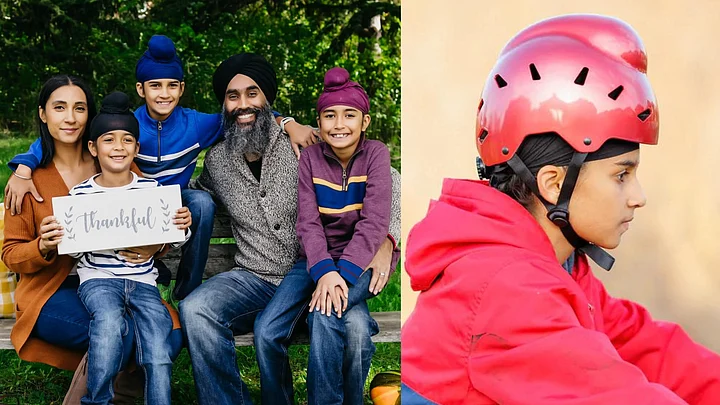When 41-year-old Tina Singh's sons, aged 10, 9, and 7, expressed their desire to learn how to ride bikes, they needed helmets for protection. However, not a single helmet would fit them unless they opened their turbans – something she did not want them to do since turbans are a sacred article of Sikh faith.
"My kids keep their hair, so anytime I went to go put a bike helmet when they were going out to ride, nothing fit them properly," Tina, who is talk show host Lilly Singh's sister, was quoted as saying by CBC News.
Having worked as an occupational therapist since 2007, Singh had dealt with a number of patients with brain injuries, and thus understood the significance of well-fitting helmets better than most.
Hence, she tried a number of ways to accommodate the helmets over her sons' turbans. She tried fitting larger helmets on their heads – which just did not fit tight, scooped out foam from inside one and even let her sons go bike-riding without the protective headgear.
However, none of the options were satisfactory.
"I was frustrated that there wasn't a safe option in sports helmets for my kids," Singh said.
Inventing the Perfect Helmet
So, she designed what she says are the first safety certified multisport helmets for her kids and other Sikh children.
For more than two years, she worked on and tested different kinds of helmets, until she found the perfect design.
Now, the helmets, she says, are in production and are certified for use while riding bicycles, inline skates, kick scooters, and skateboards for children over five years of age.
"This is a big learning curve for me, it's not something I've ever done before," she told CBC News.
What makes the helmet design unique is that it has a domed portion on top to accommodate a child's hair, and yet fits perfectly: with two finger spaces above the eyebrow, a "v shape" around the ear, and a space of one finger between the chinstrap and the ear.
In December last year, the helmet obtained a passing grade from SGS – an international testing company.
For Singh, the helmet represents not just a solution for Sikh children, but also serves as a symbol of being a part of sport.
"It is a demonstration of inclusion and diversity in sport participation," she said.
Expressing the joy she felt when she saw her children wear the helmet for the first time, Singh said, "To me it feels really surreal. It's a beautiful moment for me. I did this for my kids and to see them actually reap the benefit of that is amazing."
'Welcome Step': Sikh Groups Hail Invention
Meanwhile, several people hailed Singh's helmets, calling it "progressive" and a "welcome step".
Balpreet Singh, legal counsel for the World Sikh Organization, said:
"There are some Sikhs that do wear helmets and also many Sikhs that choose not to wear helmets because they don't feel anything should cover the turban. So I think this is definitely one more option that Sikh families can consider and definitely long overdue."
Moezine Hasham, founder of Hockey 4 Youth, said that the helmet will help Sikh children overcome obstacles to participate in sports.
"When you think about the impact of the pandemic and the access to sport that unfortunately wasn't there, the creation of this type of helmet is now going to create an inclusive space, it's going to foster belonging," he was quoted as saying by CBC News.
While Singh's helmets are made for children, the headgear for adults was in the news a few years ago.
In 2018, Ontario's Progressive Conservative government had allowed Sikhs to ride motorcycles without helmets after demands by Sikh biking groups and politician Jagmeet Singh.
The previous government had refused their demands, saying that not wearing helmets would lead to a road safety risk.
However, in a court case in 2008, a judge ruled in favour of a Sikh motorcyclist, who had refused to pay a fine for not wearing a helmet over his turban. His argument was that it was against his religion to do so.
(With inputs from CBC News.)
(At The Quint, we question everything. Play an active role in shaping our journalism by becoming a member today.)
